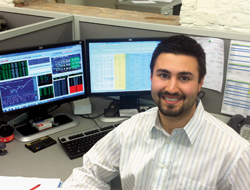For some illiquid exchange-traded funds, the price isn’t always right. Spreads can be unreasonably wide, luring the less informed to take the bait and accept a price that is far from reasonable. Fortunately, those spreads are slowly narrowing due to competition.
With illiquid funds, the screen does not always match what an ETF is really worth. If a fund rarely trades, both the bid and the offer will be posted by professional trading shops and will be skewed to a premium or a discount. That means spreads can be more than a dollar wide at times.

Even if liquidity is present, it’s not showing up in the posted prices. Recent data from Index Universe shows about 1 percent of ETFs have extremely wide spreads that equal more than 10 percent of the fund’s value—in some cases almost 50 percent. Though there are relatively few of these extreme examples, more than 10 percent of ETFs still have spreads of 100 basis points or more. The vast majority of those funds have an average daily volume of fewer than 5,000 shares.
Many in the industry are trying to help investors who want access to these lightly traded ETFs but don’t want to get soaked every time they buy or sell. Gradually, they are starting to get some of those spreads down to more reasonable levels, though certain funds still have a way to go.
Bernie Thurston, chief executive officer of Delta One Data, which focuses on indexes and ETFs, said that beginning around the middle of last year, ETF spreads started narrowing. He attributed that in part to better data from companies like his, as well as Index Universe, ETFdb and others.
“Due to the explosion in the number of products, I think traders, when they were asked to trade products that they didn’t have experience in previously, obviously widened their spreads,” Thurston said. “Now, as more and more information becomes available, those spreads will tighten up again.”
Particularly with ETFs offered by smaller providers, wide spreads can still be a problem. Thurston said when traders talk about ETFs, the liquidity of the funds is always something they discuss.
But traders should focus more on the liquidity of an ETF’s underlying constituents than on the average daily volume of the fund itself, said Rob Glownia, head trader at Richmond, Va.-based Riverfront Investment Group, which has about $3.2 billion in assets under management.
Instead of trading an illiquid ETF, some players will opt to buy the underlying basket, often using a volume-weighted average price strategy across the day. By the market’s close, they’ve bought all the component shares of that ETF and can have an authorized participant facilitate a share creation process.
Such a strategy can subject traders to market risk, but it prevents them from having to pay a premium due to a wide ETF spread.
“In certain cases, your trading costs are going to go way down, because you’re trading the actual basket, which is usually more liquid than the ETF vehicle,” Glownia said.

Of course, not everyone wants to take on market risk. One of the benefits ETFs offer over mutual funds is the ability to trade intra-day, so investors can respond to changes in the market.
Glownia said there can be another problem with this method, too. Usually the creation-redemption process has a minimum of 50,000 shares or more. Investors looking to trade fewer shares might not have access to that process, in which case they’ll have to look elsewhere.
High-Touch Approach
The agency shop WallachBeth Capital has built a niche for itself with ETFs that trade in lesser quantities. Though liquid ETFs can be plugged into algos without much of a problem, less liquid ones cannot, so WallachBeth takes a high-touch approach to its trading. The firm uses an ETF desk of 12 traders to find liquidity that doesn’t show up on the screen.
Andrew McOrmond, managing director at WallachBeth, said if a broker only calls one or two people, and counterparties know there isn’t much competition for that order, they won’t get the best price. But when a firm calls 22 people, he said, and their counterparties are aware of this, firms on the other side tend to give their best price rather than dangle an outlier number in hopes of catching a big spread.

Much of the liquidity for ETFs comes from arbitrageurs. McOrmond said these liquidity providers are valuable for price improvement, but traders should also keep in mind that they make their livings off of spreads.
“Principal traders can increase profit in ETFs as an arbitrage trade with a wider spread,” said McOrmond. That is why clients need a good broker to get better prices, he added.
Each individual product has its own characteristics. Knowing where to go for liquidity and how to trade each ETF is important for best execution.
“In ETFs, there is so much more liquidity available than what actually trades on a daily basis, ADV,” McOrmond said. “It starts with a diversified liquidity pool. Then you add negotiating and real-time pricing experience and you have true access to it.”
Some market makers are not available to public customers, as they can only trade with broker-dealers. Others may have liquidity to provide, but only a small amount. Shops like WallachBeth find that liquidity, aggregate it and provide it to the customer.
In some cases, aggregation can be the key, especially in ETFs that track tricky asset classes that force arbitrageurs to take on risk. Allowing counterparties to cut back on their own risk means they will likely be able to provide a better price.
“In a fixed-income name or a commodity name or an international name, where the underlying index is closed, instead of getting one principal trader to take on 3 million shares of risk, I can get three to agree to take on 1 million shares of risk each,” McOrmond said. “Generally, this tightens the spreads for our clients.”

The only way to ensure tighter spreads is through competition. All ETFs go through an incubation process where spreads start out more than a dollar wide and eventually come down over time. If the fund is something a lot of people want to trade, spreads will come down quickly. If it’s more of a niche product, the process will take longer.
Alan Alpers, portfolio manager for Niemann Capital Management, a Scotts Valley, Calif.-based shop with $572.5 million in assets, said many market makers post wide spreads because they can’t be bothered to closely follow funds that rarely trade. Convincing them there is a live order out there, however, can lead to price improvement.
“Once you wake them up, they tighten up the spreads a fair amount, and you end up getting reasonable prices on most things,” Alpers said.
Niemann often works with WallachBeth to ensure it gets better prices than the quoted market. Alpers said he appreciates the anonymity of going through another firm, and getting a two-sided picture of bids and offers.
Though the firm primarily invests in ETFs, less than 5 percent of the funds it uses are difficult to trade. Niemann also tends to avoid the most illiquid names, screening out ETFs that trade fewer than 25,000 shares a day.
The buyside’s hesitancy to use ETFs that are lightly traded can cause difficulties for issuers. Investors won’t trade funds unless they have a certain amount of volume, but funds can’t get volume until investors decide to trade them.
That same problem can be reflected in spreads. If spreads are wide, it scares away investors, and the resulting lack of liquidity continues to encourage wide spreads.
Hidden Liquidity
Paul Weisbruch, vice president of ETF/options sales and trading at Street One Financial, said a wide spread creates the perception that a fund isn’t liquid—even if hidden liquidity is available. That means the potential price impact for the investor is exaggerated.
“You bring it up on your trading screen, and to see it with a dollar-wide spread, it gives you great pause in using the vehicle,” Weisbruch said.
To trade these ETFs, clients have to be in touch with a desk that can tap into hidden liquidity. With some market makers electronically quoting more than 1,000 ETFs, they just can’t devote much attention to products that don’t trade, Weisbruch said.
Last year, Nasdaq OMX proposed allowing issuers of ETFs to pay market makers for keeping their funds liquid. The Securities and Exchange Commission rejected the initial proposal in December, citing technical issues. Nasdaq revised its filing, and last month regulators published the proposed rule change in the Federal Register, seeking public comment.

Nasdaq said in its filing with the SEC the voluntary program would benefit traders and investors by encouraging more quote competition, narrower spreads and greater liquidity. The exchange stressed the only way a market maker could earn credits under the program would be to maintain a quality market.
Though traders in the know can often receive better prices than what is quoted, the proposal aims to give all traders access to the best markets possible.
The idea has received initial support from issuers, market makers and authorized participants, but it is unclear whether it will ever be approved by the SEC. In the meantime, investors wanting to trade certain ETFs would be well advised to find traders who won’t just take a quoted price on a screen at face value.
According to Street One’s Weisbruch, clients need to use a brokerage that has expertise in trading illiquid ETFs, that know not just how to get the trade done, but also how to get prices close to the value of a fund’s underlying assets.
“The majority of buyside managers are still trading these as if they were stocks,” Weisbruch said. “It creates a huge opportunity for those on the other side of the trade, for high-frequency traders and statistical-arbitrage-type hedge funds.”
These players jump into trades and arbitrage away the difference, but if the managers had a little bit more information, there wouldn’t be quite as much opportunity for the arbitrageurs to cash in and reduce alpha for the buyside, Weisbruch said.
Education the Key
Buysiders might be tempted to pick a midpoint between the posted offer and bid, but the value of the underlying assets in an ETF could be much closer to one than the other. In such a case, executing at the midpoint could leave the buyside getting soaked.
Weisbruch said the more difficult a basket is to assess, the more difficult the ETF is to trade, but being able to quickly and accurately assess the value of the basket can help traders know what the price should be.
“You have a vast amount of misinformation on the institutional front,” Weisbruch said. “Education is improving, albeit a little bit slower than we would like it to.”
SunGard’s Fox River Execution has also tried to better educate the buyside on lightly traded ETFs. That way, managers can decide for themselves if the bids and offers posted are justified.
Paul Daley, head of product management for Fox River, said to identify the fair price of an ETF, a trader has to have data about the underlying assets of a fund and be able to process that data in real time.
“There are some cases where the bid-offer spread is justified, and then there are other cases where it is not, but distinguishing between those two just by looking at the spread is a near impossibility,” Daley said. “You have to look at what is going on in the underlying securities.”
Fox River offers real-time data for the underlying basket, arguing it is necessary for traders to have that data so they can protect themselves with limit orders.
“You are paying a commission to a broker for a reason,” Daley said. “You need that broker to set intelligent limits for you, and if they’re not doing that, find one that will.”




